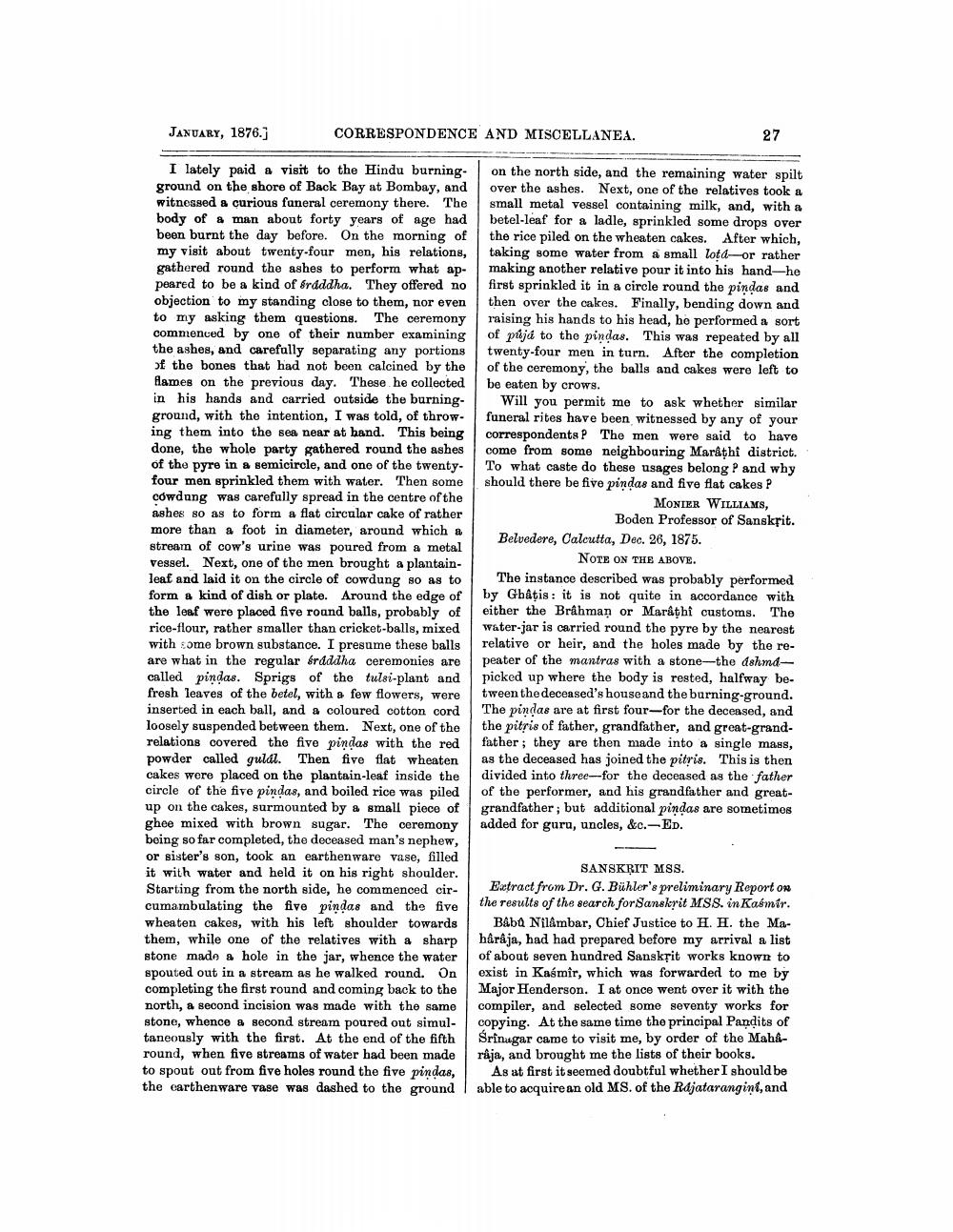________________
JANUARY, 1876.]
CORRESPONDENCE AND MISCELLANEA.
27
I lately paid a visit to the Hindu burning. ground on the shore of Back Bay at Bombay, and witnessed a curious faneral ceremony there. The body of a man about forty years of age had been burnt the day before. On the morning of my visit about twenty-four men, his relations, gathered round the ashes to perform what appeared to be a kind of Sraddha. They offered no objection to my standing close to them, nor even to my asking them questions. The ceremony commenced by one of their number examining the ashes, and carefully separating any portions of the bones that had not been calcined by the fames on the previous day. These he collected in his hands and carried outside the burningground, with the intention, I was told, of throw. ing them into the sea near at hand. This being done, the whole party gathered round the ashes of the pyre in a semicircle, and one of the twentyfour men sprinkled them with water. Then some cowdang was carefully spread in the centre of the ashes so as to form a flat circular cake of rather more than a foot in diameter, around which a stream of cow's urine was poured from a metal vessel. Next, one of the men brought a plantainleaf and laid it on the circle of cowdung so as to form a kind of dish or plate. Around the edge of the leaf were placed five round balls, probably of rice-flour, rather smaller than cricket-balls, mixed with some brown substance. I presume these balls are what in the regular érdddha ceremonies are called pindas. Sprigs of the tulsi-plant and fresh leaves of the betel, with a few flowers, were inserted in each ball, and a coloured cotton cord loosely suspended between them. Next, one of the relations covered the five pindas with the red powder called gulal. Then five flat wheaten cakes were placed on the plantain-leaf inside the circle of the five pindas, and boiled rice was piled up on the cakes, surmounted by a small piece of ghee mixed with brown sugar. The ceremony being so far completed, the deceased man's nephew, or sister's son, took an earthenware vase, filled it with water and held it on his right shoulder. Starting from the north side, he commenced circumambulating the five pindas and the five wheaten cakes, with his left shoulder towards them, while one of the relatives with a sharp stone made a hole in the jar, whence the water spouted out in a stream as he walked round. On completing the first round and coming back to the north, a second incision was made with the same stone, whence & second stream poured out simul- | taneously with the first. At the end of the fifth round, when five streams of water had been made to spout out from five holes round the five pindas, the earthenware vase was dashed to the ground
on the north side, and the remaining water spilt over the ashes. Next, one of the relatives took a small metal vessel containing milk, and, with a betel-leaf for & ladle, sprinkled some drops over the rice piled on the wheaten cakes. After which, taking some water from a small lotdor rather making another relative pour it into his hand-he first sprinkled it in a circle round the pindas and then over the cakes. Finally, bending down and raising his hands to his head, he performed a sort of půjá to the pindas. This was repeated by all twenty-four men in turn. After the completion of the ceremony, the balls and cakes were left to be eaten by crows.
Will you permit me to ask whether similar funeral rites have been witnessed by any of your correspondents P The men were said to have come from some neighbouring Marathi district. To what caste do these usages belong P and why should there be five pindas and five flat cakes P
MONIER WILLIAMS,
Boden Professor of Sanskrit. Belvedere, Calcutta, Dec. 26, 1875.
NOTE ON THE ABOVE. The instance described was probably performed by Gbâtis: it is not quite in accordance with either the Brahman or Marathi customs. The Water jar is carried round the pyre by the nearest relative or heir, and the holes made by the repeater of the mantras with a stone-the dshmdpicked up where the body is rested, halfway between the deceased's house and the burning-ground. The pindas are at first four-for the deceased, and the pitris of father, grandfather, and great-grandfather, they are then made into a single mass, as the deceased has joined the pitris. This is then divided into three--for the deceased as the father of the performer, and his grandfather and greatgrandfather, but additional pindas are sometimes added for guru, uncles, &c.- ED.
SANSKRIT MSS. Etract from Dr. G. Bühler's preliminary Report on the results of the search for Sanskrit MSS. in Kasmir.
Baba Nilambar, Chief Justice to H. H. the Mahåråja, had had prepared before my arrival a list of about seven hundred Sanskrit works known to exist in Kasmir, which was forwarded to me by Major Henderson. I at once went over it with the compiler, and selected some seventy works for copying. At the same time the principal Pandits of Srinugar came to visit me, by order of the Mahlraja, and brought me the lists of their books.
As at first it seemed doubtful whether I should be able to acquire an old MS. of the Rdjatarangini, and




